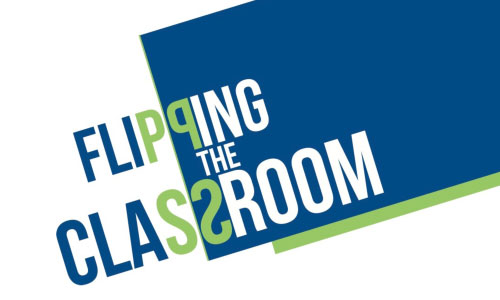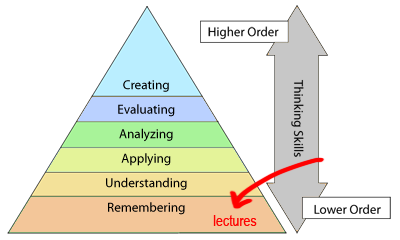
by Brad Reamsbottom
A question that is often discussed by the Teaching Centre is whether or not lectures are effective, or are lectures effective use of class time. The answer to that question of course will vary according to what you want your students to learn, as well as how comfortable you feel lecturing to your students.
If we look at Bloom’s Taxonomy and where on this scale lecturing fits, we can see that lecturing is considered to produce lower order thinking skills. Lecturing often is looked at as having a lower retention rate for what is learned, while having the students teach about a particular topic will have a higher retention rate for learning. This does not mean that lecturing is completely ineffective, it just means that it is only one way of disseminating information for learning. In cases where foundational knowledge must be disseminated to the students lecturing is often an effective tool.

However, there are some different ways we can incorporate the lecture to make the best use of face to face time with the students. If lecturing is a one way communication tool, then having students study the lecture material on their own time might free up more class time. In its place you could incorporate more discussion, group projects and other activities. All of these activities generally have a higher percentage of learning retention than lecture. Placing the lecture online for students to access as part of their homework is one method of “flipping the classroom.” It is considered flipping the classroom because you are moving the lecture into the realm of homework rather than a standard in-class activity.
There are a few things to consider if you want to flip your classroom by putting lectures online. First consider how you wish the students to use their time. What did you normally have them do outside of class time? Keep in mind that if you normally lecture for 30 minutes of a 50 minute class, you are now adding 30 minutes of homework to your students activities outside of class. You should structure asynchronous homework and activities accordingly. Do not ask your students to add 30 minutes of lecture time to their evenings if you don’t plan on lightening up on reading or other activities. Also keep in mind the length of lectures you are posting. If you find you keep your lectures to 30 minutes in order to keep your students attention, then don’t try and extend the lectures when you move to an online format. It would probably be good practice to even shorten the lectures if at all possible. Another strategy could be to chunk your lecture into 2 or 3 pieces, so it is available to your students in bite size chunks. Remember the goal of flipping the classroom is to take the lecture out of the class, not double the workload of the student.
Another aspect to consider is what you will do in place of a lecture when your class meets face to face. Will you have students work in groups, or will you increase the amount of class discussion? Whatever you choose, make sure you are prepared for your class once you make the change. If you plan on increasing your discussion time in class, then have a plan. Make the discussion relevant to the lectures you had students watch online. Ask them questions pertinent to the videos. Do not assume that because students often have questions after class, that they will be eager to discuss those questions when you incorporate more discussion time. Consider asking students to submit their questions regarding the online lectures via email or an online discussion forum. This has a couple of benefits. First, you can use student comments to feed the discussion during the next face to face meeting. Second, it will be an incentive to actually watch the online lecture. Third, having students submit comments is also a great way for them to reflect on the material they just watched.
Be aware of your time, and how much time it takes to flip a classroom. There is no way around the time and effort required to get your lectures up online. Get a good grasp as to how much time building these videos takes. Do you have the skills to build these videos? Do you need help producing the videos? Don’t try to change everything if you don’t have the time to prepare for the change.
If time is a constraint, consider only flipping some of your lectures rather than all of them. This will allow you to try out the flipped classroom for specific lectures and gather formative feedback from your students as to how they liked the idea of a flipped class.
As with any change to the how a course runs, it is essential that the students are informed. We need to be cognizant of the fact that many courses utilize the in-class lecture format. Student are familiar with this format. If you are planning on making significant changes to the course, be sure to inform your students and clarify any questions they may have about what is expected of them.
Whether you are lecturing face to face or if you are putting your lectures online, be sure to have a plan. Make sure you know why you are flipping your classroom. Have a justified reason to make this significant change. As with any change in your course, the goal should be to improve teaching effectiveness and student learning.
If you are planning on changing some aspect of your course, such as the move to online lectures, contact the Teaching Centre to see if they can assist you. teachingcentre@uleth.ca